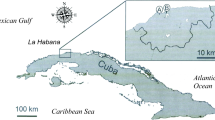Abstract.
The number of individuals allergic to plant pollen has recently been on a constant increase, especially in large cities and industrial areas. Therefore, monitoring of airborne pollen types and concentrations during the pollen season is of the utmost medical importance. The research reported in this paper aims to determine the beginning, course and end of the pollen season for the plants in the City of Zagreb, to identify allergenic plants, and to assess the variation in airborne pollen concentration as a function of temperature and precipitation changes for the year 2002. A volumetric Hirst sampler was used for airborne pollen sampling. Qualitative and quantitative pollen analysis was performed under a light microscope (magnification ×400). In the Zagreb area, 12 groups of highly allergenic plants (alder, hazel, cypress, birch, ash, hornbeam, grasses, elder, nettles, sweet chestnut, artemisia and ambrosia) were identified. Birch pollen predominated in spring, the highest concentrations being recorded in February and March. Grass pollen prevailed in May and June, and pollen of herbaceous plants of the genus Urtica (nettle) and of ambrosia in July, August and September. Air temperature was mostly higher or considerably higher than the annual average in those months, which resulted in a many days with high and very high airborne pollen concentrations. The exception was April, when these concentrations were lower because of high levels of precipitation. This also held for the first half of August and the second half of September. Pollen-sensitive individuals were at high risk from February till October because of the high airborne pollen concentrations, which only showed a transient decrease when the temperature fell or there was precipitation.



Similar content being viewed by others
References
Bagni N, Charpin H, Davies RR, Nolard N, Stix E (1976) City spore concentrations in the European Economic Community (ECC). I. Grass pollen 1973. Clin Allergy 6:61–68
Bringfelt B (1982) An evaluation of some models to predict airborne pollen concentration from meteorological conditions in Stockholm, Sweden. Grana 21:59–64
Conrad V, Pollak LW (1950) Methods in climatology. Harvard University Press, Cambridge, Mass 459
Cvitanović S (1999) Allergy to Parietaria officinalis pollen. Croat Med J 40:42–48
Cvitanović S, Marušić M (1994) Hypersensitivity to pollen allergens on the Adriatic coast. J Invest Allergol Clin Immunol 4:96–100
Cvitanović S, Marušić M, Zekan L, Kohler-Kubelka N (1986) Allergy induced by Parietaria pollen in Southern Croatia. Allergy 41:543–545
D’Amato G, Spieksma FTM (1990) Allergenic pollen in Europe. Grana 30:67–70
Emberlin J, Savage M, Woodman R (1993) Annual variations in the concentrations of Betula pollen in the London area, 1961–1990. Grana 32:359–363
Frenguelli G, Spieksma FTM, Bricchi E, Romano B, Mincigrucci G, Nikkels AH, Dankaart W, Ferranti F (1991) The influence of air temperature on the starting dates of the pollen season of Alnus and Populus. Grana 30:196–200
Hirst JM (1952) An automatic volumetric spore trap. Ann Appl Biol 39:257–265
Hofman T, Michalik J (1998) Alergia Pylkowa. Wyd. TOM, Poznan
Ipsen H, Lind P (1985) IgE binding epitopes of the major allergens of adler, birch and hazel. Ann Allergy 55:288
Juras V, Juras J (1987) Metode kategorizacije izvanrednih meteoroloških pojava, Zbornik radova s III jugoslavenskog savjetovanja o elementarnim atmosferskim nepogodama. Opasne pojave na moru. RHMZ, Split, pp 1–9
Lejoly-Gabriel M, Leuschner RM (1983) Comparison of airborne pollen at Louvain-la-Neuve (Belgium) and Basel (Switzerland) during 1979 and 1980. Grana 22:59–64
Leuschner RM (1978) Registrierte Luftpollen von Ambrosia als Hinweis auf ein Vorkommen dieser Advertivpflanzen. Bauhinia 6:265–271
Nilsson S, Palmberg-Gothard J (1980) Pollen calendar for Huddinge (Sweden), 1973–1980. Grana 21:183–185
Nilsson S, Persson S (1981) Tree pollen spectra in the Stockholm region (Sweden), 1973–1980. Grana 20:179–182
Obtulowicz K, Kotlinowska T, Stobiecki M, Dechnik K, Obtulowicz A, Manecki A, Marszalek M, Schejbal-Chwastek M (1996) Environmental air pollution and pollen allergy. Ann Agric Environ Med 3:131–138
Penzar B (1976) Klima makroregionalnih gradova SR Hrvatske. In: Centralna naselja i gradovi SR Hrvatske. Školska knjiga, Zagreb, pp 163–191
Perrin I, Brunet J, Dechamp C (1977) Total IgE and specific IgE in the summer and autumn pollinosis (ragweed and mugwort). Rev Fr Allergol Immunol Clin 17:265–267
Raynor GS (1979) Sampling techniques. Aerobiology. The Ecological System Approach US/IBP Synthesis Series 10:151–169
Reed CE (1997) New insights into allergic rhinitis: quality of life, associated airway diseases and antihistamine potency. Allergy Clin Immunol 99:739–806
Severova E, Polevova S (1996) Aeropalynological calendar for Moscow 1994. Ann Agric Environ Med 3:115–119
Spieksma FTHM, D’Amato G, Mullins J, Nolard N, Wachter R, Weeke ER (1989a) City spore concentrations in the European Economic Community (ECC). VI. Poaceae (grasses) 1982–1986. Aerobiologia 5:38–43
Spieksma FTHM, Frenguelli G, Nikkels AH, Minegrucci G, Smithuis LOMJ, Dankaart W, Romano B (1989b) Comparative study of airborne pollen concentrations in central Italy and The Nederlands (1982–1985). Grana 28:25–36
Strandhede SO, Wihl JA, Erikkson NE (1984) Tree pollen allergy 1. Features of plant, geography and pollen counts. Allergy 39:602–609
Volarić-Mršić I (1960) Study of pollen in the air of Zagreb. Acta Allergol 15:43–52
Volarić-Mršić I (1970) Istraživanje polena u uzduhu u nekim krajevima Hrvatske. Acta Bot Croat 29:83–94
Volarić-Mršić I (1972) Investigation on aeroplankton at Crikvenica. Acta Bot Croat 31:139–145
Volarić-Mršić I (1974) Pollen calendars for Croatia. In: Charpin R, Surinyach R (eds) Atlas of European allergenic pollens. Sandoz, Paris, pp 221–227
Zanon P, Chiodini E, Berra D (2002) Allergy to ragweed in northern Italy and prevention strategies. Monaldi Arch Chest Dis 57:144–146
Weber RW (1998) Pollen identification. Ann Allergy Asthma Immunol 80:235–240
Wütrich B, Helbing A, Primault B, Cour P, Duzer D (1983) Pollinosis. III. Pollenkalendar von Zürich mit den allergologisch wichtigsten Pollenarten. Schweiz Med Wochenr 113:170–183
Author information
Authors and Affiliations
Corresponding author
Rights and permissions
About this article
Cite this article
Peternel, R., Srnec, L., Čulig, J. et al. Atmospheric pollen season in Zagreb (Croatia) and its relationship with temperature and precipitation. Int J Biometeorol 48, 186–191 (2004). https://doi.org/10.1007/s00484-004-0202-x
Received:
Revised:
Accepted:
Published:
Issue Date:
DOI: https://doi.org/10.1007/s00484-004-0202-x




